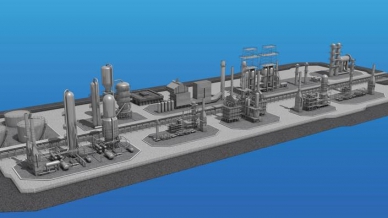
FCC units are the “money makers” of gasoline refineries. The pressure is on for operators to avoid delays in startup and to keep the units up and running. Accurate dipleg temperature measurement and monitoring ensures appropriate conditions for startup and prevents costly downtime.
Fluid catalytic cracking (FCC) units are the most profitable units in gasoline refineries. An FCC unit that is not running causes substantial financial losses, yet it has to be shut down every five years or so for normal maintenance. It is of utmost importance to minimize this downtime and to get the unit restarted as soon as possible. Startups, however, are one of the most complicated and dangerous processes for a FCC unit.
The startup process begins with warming the FCC unit first with hot nitrogen, and then with steam. At this latter stage, the temperature of the diplegs’ skin has to be above dew point. If not, the steam condenses when it hits the cooler metal of the dipleg, which wets the catalyst. Moist catalyst is sticky, does not flow properly, and tends to clump. These suboptimal conditions plug (bridge) the catalyst circulating system, resulting in uneven flows and temperatures inside the unit.
When the catalyst becomes wet, the startup process often has to be aborted. Restarting the unit requires first cleaning the system, and then warming it again. All this downtime is expensive.
How to Avoid Problems during Startup
To prevent the catalyst from getting wet, operators must be certain that the temperature of the dipleg skin is above dew point before introducing steam. Startup permissive and monitoring tools, including a multipoint temperature measurement system, help ensure a safe and successful startup.
The combination of the Gayesco Flex-R® multipoint thermocouple system and the Gayesco Xtracto-Pad® removable skin thermocouple assembly helps ensure dependable startups. Heavy walls shield the Gayesco Flex-R® from an FCC unit’s erosive environment. The thermocouples are accurate and have a fast response time, providing real-time temperature measurements. What’s more, the thermocouples can be repaired or replaced on site.
The specially engineered Gayesco Xtracto-Pad® has a removable skin thermocouple guide tube and shield that allow skin temperature measurement without interference. The guide tube and shield can be attached to the diplegs when these are outside the FCC unit. This configuration simplifies welding and inspection in what otherwise would be a confined space. It also allows replacing the thermocouple without re-welding. Insertion through the nozzle is easy in thermocouples without welded pads, and there is no need to automatically replace the thermocouple bundle every time diplegs wear out.
Using both the Gayesco Flex-R® and Gayesco Xtracto-Pad® allows accurate evaluation of temperature inside an FCC unit at startup, turning a major challenge into a controlled process. For questions or concerns about the startup of your FCC unit, contact the experts at WIKA USA.
Click here to enter our interactive refinery to learn more about WIKA product applications.


